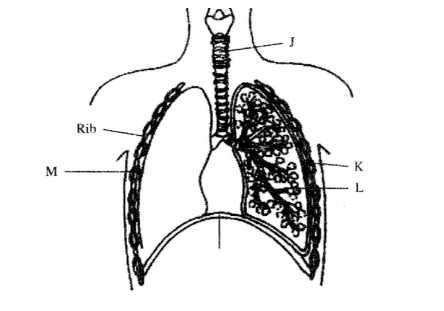
2016 Biology Paper 2
1. The diagram below represents a human foetus in a uterus.

(a) Name the part labeled S. (1 mark)
(h) (i) Name the types of blood vessels found in the structure labeled Q. (2 marks)
(ii) State the difference in composition of blood found in the vessels named in
(b) (i) above. (2 marks)
(c) Name two features that enable the structure labeled P to carry out its function. (2 marks)
(d) State the role of the part labeled R. (1 mark)
2. (a) How is sex determined in man? (4 marks)
(b) (i) Differentiate between sickle cell anaemia and sickle cell trait. (2 marks)
(ii) Explain why people with sickle cell trait have an adaption survival advantage over normal individuals in malaria endemic regions. (2 marks)
3. The diagram below represents bones at a joint found in the hind limb of a mammal.

(a) Name the bones labeled X, Y and Z (3 marks) X: Y:
(b) (i) Name the substance found in the place labeled W. (I mark)
(ii) State the function of the substance named in (b) (i) above. (1 mark)
(c) Name the structure that joins bones together at the joint. (I mark)
(d) State the difference between ball and socket joint and the one illustrated in the diagram aboNe. (1 mark)
(e) Name the structure at the elbow that performs the same function as the patella. (1 mark)
4. The diagram below represents some gaseous exchange structures in humans.

(a) Name the structures labeled K, L and M. (3 marks)
(b) How is the structure labeled J suited to its function? (3 marks)
(c) Name the process by which inhaled air moves from the structure labeled L into blood capillaries. ( I mark)
(d) Give the scientific name of the organism that causes tuberculosis in human (1 mark)
5. A freshly obtained dandelion stern measuring 5cm long was split lengthwise to obtain two similar pieces.
The pieces were placed in two different solutions of different concentrations in petri dishes (L. and L2) for 20 minutes. The appearance after 20 minutes is as shown.

(a) Account tbr the appearance of the pieces in solutions L. and L2. (6 marks)
(b) State the significance of the biological process involved in the experiment. (2 marks)
SECTION B (40 marks)
Answer question 6 (compulsory) and either question 7 or 8 in the spaces provided after question 8.
6. An experiment was carried out to investigate the effect of temperature on the rate of reaction catalysed by an enzyme. The results are shown in the table below.

(a) On the grid provided plot the rate of reaction against temperature. (6 marks)

(b) When was the rate of reaction 2.6 mg of product per unit time? (2 marks)
(c) Account for the shape of the graph between:
(i) 5°C and 40°C (2 marks)
(ii) 45°C and 60°C (3 marks)
(d) Other than temperature name two ways in which the rate of reaction between 5°C and 40°C could be increased. (2 marks)
(e) (i) Name one digestive enzyme in the human body which works best in acidic condition. (1 mark)
(ii) How is the acidic condition for the enzyme named in
(c) (i) above attained? (2 marks)
10 (f) The acidic condition in
(e) (iii) above is later neutralized.
(i) Where does the neutralization take place? (1 mark)
(ii) Name the substance responsible for the neutralization. (1 mark)
7. Using a relevant example in each case, describe simple and conditional reflex actions. (20 marks)
8. Describe how the mammalian heart is structurally adapted to its function. (20 marks)
